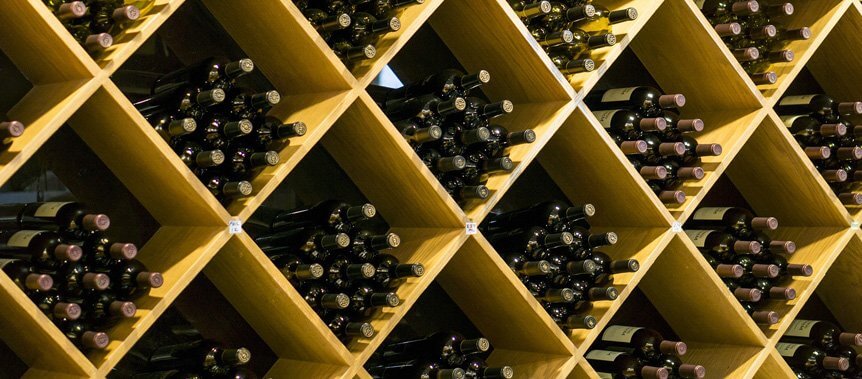Proper wine storage is essential for every wine collection. Only about 10% of the wine in the world needs to be aged before reaching peak quality. During the process of aging, the wine gains complexity defined in terms of flavors, aromas, texture, and overall enjoyment. The other 90% of the world’s vino doesn’t involve a waiting period before serving. But no matter what type is in your collection, knowing how to properly store your wine collection is critical.
Wine Storage for the Average Wine Drinker
Among all the bottles of wine available for purchase at any given moment, approximately 94% or more are categorized as “ready-to-drink” wines. When manufactured, the purpose is for immediate consumption. Time spent in a precise type of environment does not improve these wines. Keeping them in proper wine storage conditions does, however, protect and maintain their peak quality.
Quality of Ready-to-Drink Wines
Wines that are ready-to-drink upon purchase are far less expensive for the winemakers to produce, but that does not mean they are necessarily of lower quality than wine that ages. Many ready-to-drink wines are high-quality wines enjoyed by the most avid wine lovers and connoisseurs. For up to a year, most ready-to-drink wines can be stored in wine cellar-type conditions without a significant downgrade in quality.
How to Properly Store a Wine Collection
The following are the essential elements of proper wine storage for all wine collections: Darkness, temperature, humidity, ventilation, and security.
Protection from UV Light
Proper wine storage keeps out sunlight because the sun’s UV rays alter the balance of wine. To further combat this negative effect, most wine cellar doors have UV protection. Wine bottles are usually dark in color, which is another layer of protection. It doesn’t take much for wine to be affected. For instance, experts say that when storing a white wine in a basic refrigerator, the UV light that comes on when the door opens has a bad effect on wine quality. The lights in a wine cellar can potentially do the same. Fluorescent lights create UV rays that are harmful to wine and should be not be used around wine collections. LED lights are highly recommended for wine storage areas because they don’t give off heat or UV rays.
Temperature
The ideal temperature range for storing wine is between 52°F to 58°F. It is important that the temperature sustained for wine storage is stable, constant, and does not fluctuate. According to experts, an acceptable rate of temperature fluctuation is only about 5° F once within a year.
Aging wine is a complex process. A fragile balance must be maintained so that various chemical reactions in the wine occur at a slow and natural pace. If a bottle of wine meant to age for a decade is stored at 78°F could only be good for only a few months before passing its peak quality. The acceleration also creates imbalances, so that the wine cannot reach peak quality when stored at temperatures higher than 58°F.
Humidity
Proper storage of a wine collection involves maintaining relative humidity in the range of 60 to 80 percent. The effects of humidity on wine corks is part of the reason for this requirement.
The cork used to seal a bottle of wine plays a role in the aging process. A minuscule level of oxygen gets into the wine through natural cork and contributes to the optimal aging process. If the air lacks humidity, corks dry out, causing them to shrink and crack. This allows more air into the bottle, which spoils the wine over time.
When the humidity level for wine storage is too high, there are different risks. Mildew or mold could begin to thrive, and wine labels can be damaged.
Ventilation
The environment a wine collection is stored in must be free of odors, including musty smells. This makes ventilation of the storage area important. Certain things should never be kept in a wine storage area because odors can seep through corks, spoiling the wine. Cleaning solutions and painting should be avoided where you store your wine because they contain harmful and highly volatile chemical compounds. Aromatic foods such as cheeses, garlic, onions, and others should never be stored with wine either.
Orientation of your Wine
The orientation of your wine bottles in your home or in storage can help with the longevity of your wine. Ideally you would store your wine on a wine rack which allows your bottles to rest on their sides. The reason you store wine like this is because the wine keeps the corks moist and prevents it from cracking or shrinking.
Security
Security isn’t an environmental issue, but it is important for a wine collection. Without security measures, your wine is vulnerable to being damaged or lost due to theft, equipment failure, or fire.
You may trust your friends and family, but the reality is that your wine cellar may be too big a temptation for teenagers as well as certain friends and relatives. Wine should also be protected from the types of thieves who break in and steal. Every wine storage area should have a lock on the door, and wine collections should be insured.
Enjoy your Wine Collection!
Your wine collection is an investment, no matter how substantial. Maintaining the right environment and including security are essentials for protecting your investment. Knowing how to properly store your wine collection also helps to ensure that you can enjoy your wines at their times of optimal quality.

